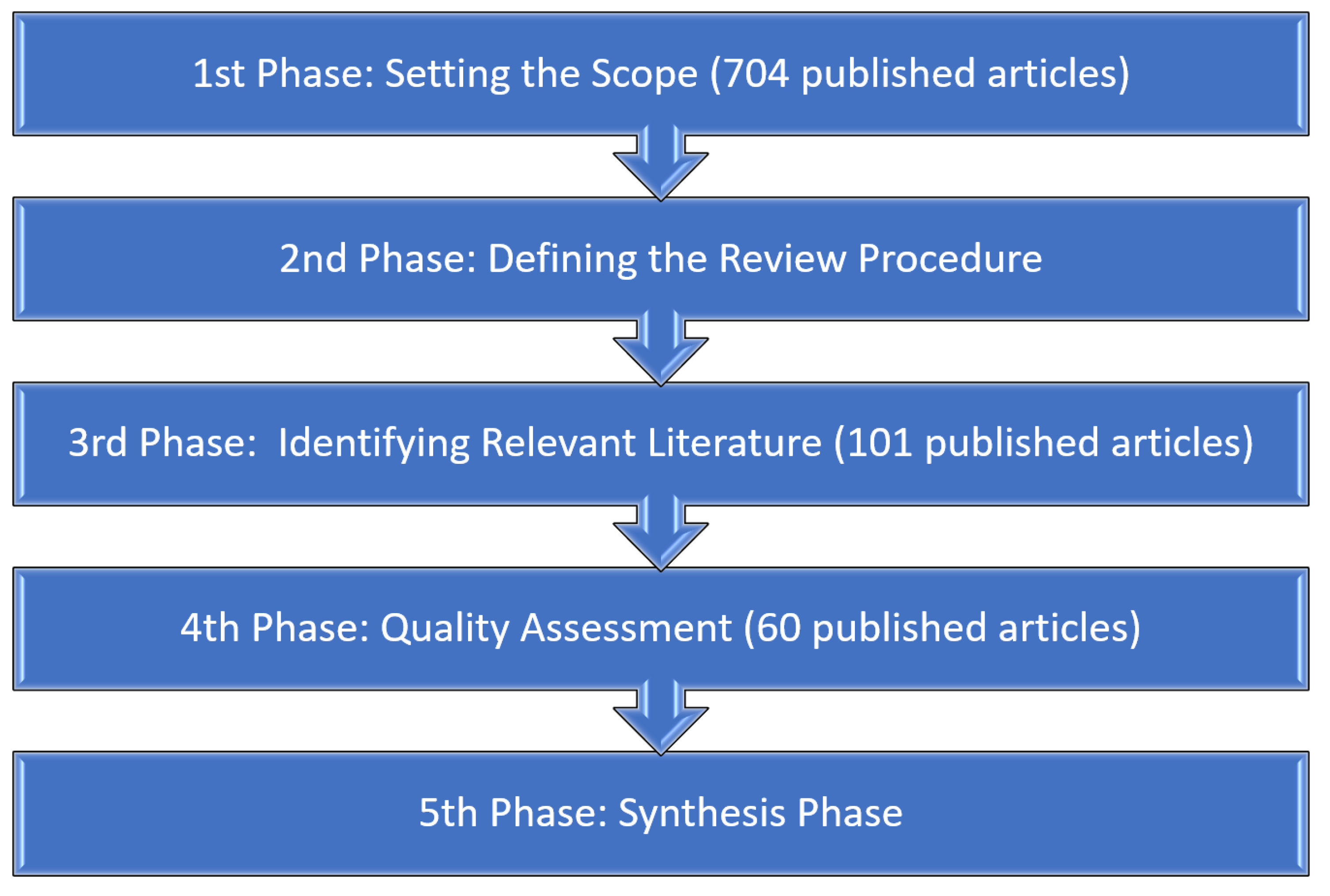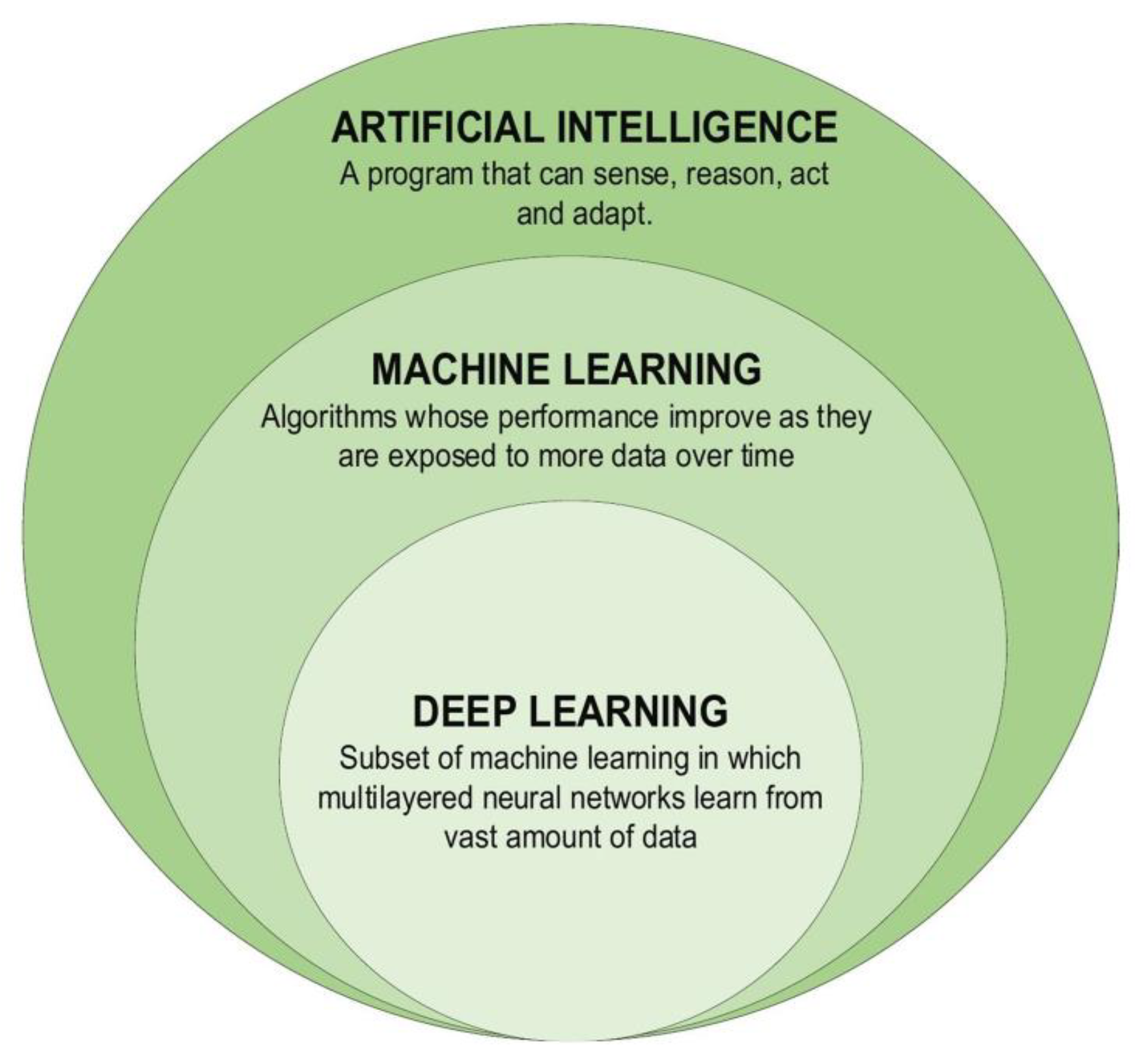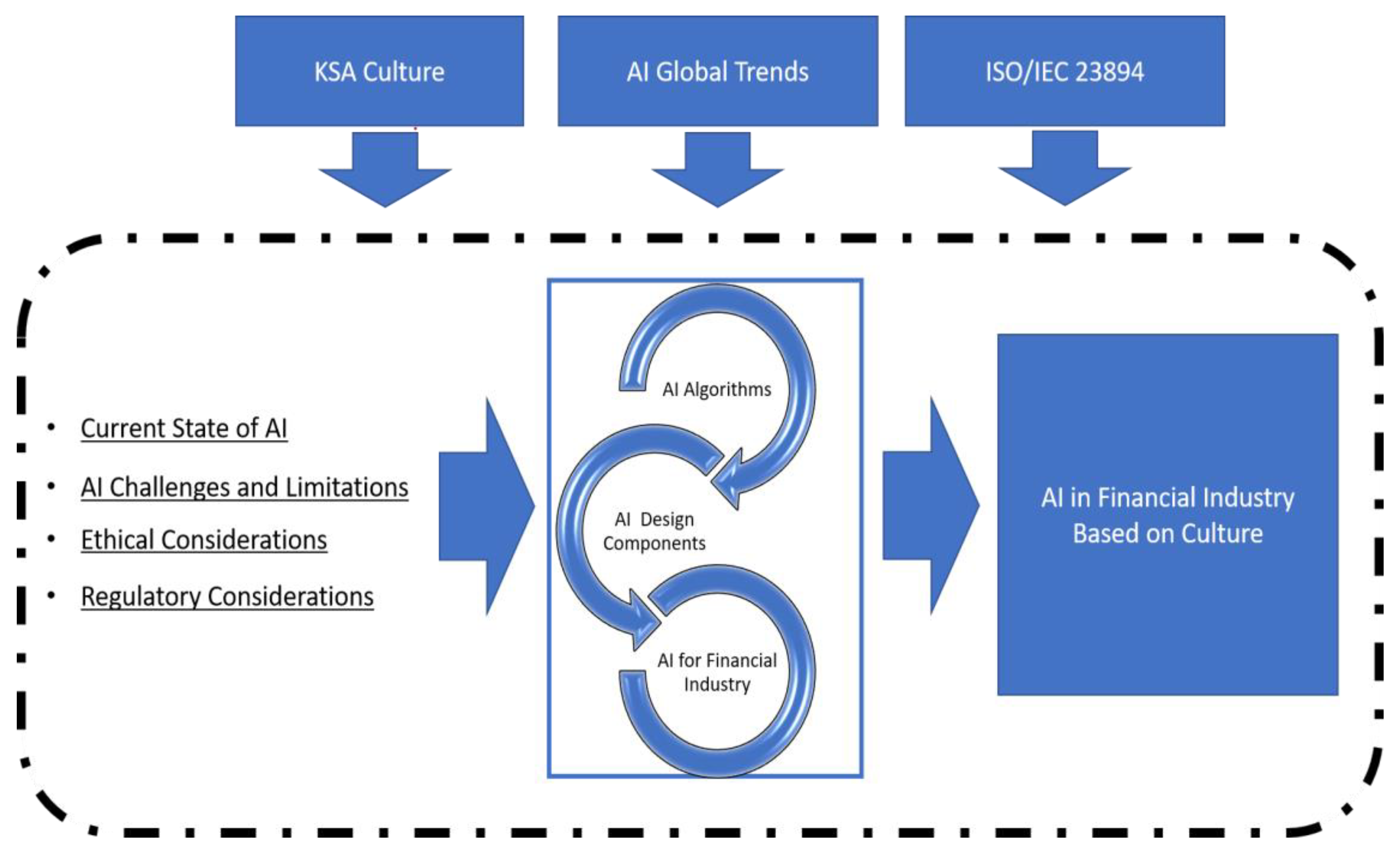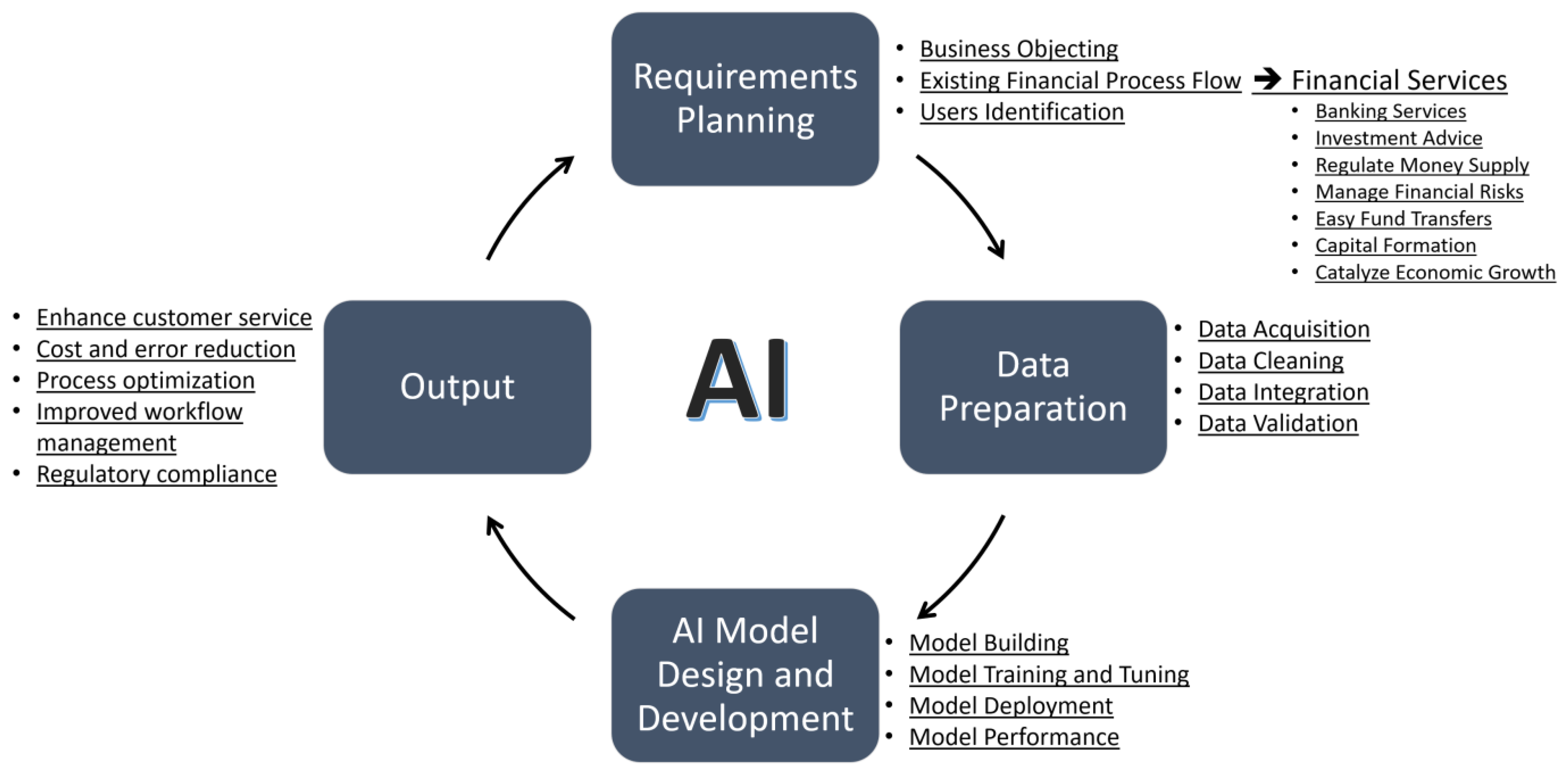The Artificial Intelligence Revolution in Digital Finance in Saudi Arabia: A Comprehensive Review and Proposed Framework
Abstract
:1. Introduction
- What is the current state of implementation of AI technologies in the financial industry in KSA?
- What are the benefits, limitations, and challenges of leveraging AI in the KSA financial industry?
- What ethical and regulatory considerations must be taken to ensure the successful adoption of AI technologies in the KSA financial industry?
- What design framework could be proposed utilizing significant AI design components and algorithms tailored to the financial industry’s needs?
2. Methodology
3. The Current State of Deploying AI in the Financial Industry in KSA
4. Leveraging AI in the Saudi Financial Industry
4.1. Benefits and Limitations
4.2. Challenges
5. Ethical and Regulatory Considerations
5.1. Ethical Considerations
5.2. Regulatory Considerations
6. Significant AI Components and Their Algorithms
6.1. Significant Components
6.2. Algorithms
6.2.1. ML Approach
6.2.2. DL Approach
7. The Proposed Frameworks
8. Conclusions
Funding
Institutional Review Board Statement
Informed Consent Statement
Data Availability Statement
Conflicts of Interest
References
- Singh, A.M.; Haju, W.B. Artificial Intelligence. Int. J. Res. Appl. Sci. Eng. Technol. 2022, 10, 1210–1220. [Google Scholar] [CrossRef]
- Hentzen, J.K.; Hoffmann, A.; Dolan, R.; Pala, E. Artificial intelligence in customer-facing financial services: A systematic literature review and agenda for future research. Int. J. Bank. Mark. 2022, 40, 1299–1336. [Google Scholar] [CrossRef]
- Buchanan, B.G. Artificial Intelligence in Finance; Zenodo: Geneva, Switzerland, 2019. [Google Scholar] [CrossRef]
- Sahu, S.K.; Mokhade, A.; Bokde, N.D. An Overview of Machine Learning, Deep Learning, and Reinforcement Learning-Based Techniques in Quantitative Finance: Recent Progress and Challenges. Appl. Sci. 2023, 13, 1956. [Google Scholar] [CrossRef]
- Gogas, P.; Papadimitriou, T. Machine Learning in Economics and Finance. Comput. Econ. 2021, 57, 1–4. [Google Scholar] [CrossRef]
- Lakhchini, W.; Hassan, U. Artificial Intelligence & Machine Learning in Finance: A Literature Review; Zenodo: Geneva, Switzerland, 2022. [Google Scholar] [CrossRef]
- Goodell, J.W.; Kumar, S.; Lim, W.M.; Pattnaik, D. Artificial intelligence and machine learning in finance: Identifying foundations, themes, and research clusters from bibliometric analysis. J. Behav. Exp. Financ. 2021, 32, 100577. [Google Scholar] [CrossRef]
- Organisation for Economic Co-Operation and Development, Artificial Intelligence, Machine Learning and Big Data in Finance: Opportunities, Challenges, and Implications for Policy Makers. 2021. Available online: https://www.oecd.org/finance/artificial-intelligence-machine-learning-big-data-in-finance.htm (accessed on 20 March 2023).
- Zhang, X.P.; David, K. A Budding Romance: Finance and AI. 2018. Available online: https://www.computer.org/multimedia (accessed on 20 March 2023).
- Sanz, J.L.C.; Zhu, Y. Toward Scalable Artificial Intelligence in Finance. In Proceedings of the 2021 IEEE International Conference on Services Computing (SCC), Chicago, IL, USA, 5–10 September 2021; pp. 460–469. [Google Scholar]
- Ourdani, N.; Chrayah, M. Big Data and public finance sector. In Proceedings of the 2022 International Conference on Intelligent Systems and Computer Vision, ISCV 2022, Fez, Morocco, 18–20 May 2022; Institute of Electrical and Electronics Engineers Inc.: New York, NY, USA, 2022. [Google Scholar] [CrossRef]
- Soni, P. A Study on Artificial Intelligence in Finance Sector. 2021. Available online: https://www.ijcrt.org (accessed on 20 March 2023).
- Munawwar, A.S. Artificial Intelligence in Saudi Arabia: Leveraging Entrepreneurship in the Arab Markets. In Proceedings of the 2019 Amity International Conference on Artificial Intelligence (AICAI), Dubai, United Arab Emirates, 4–6 February 2019; IEEE: Toulouse, France, 2019. [Google Scholar]
- Nasir, O.; Javed, R.T.; Gupta, S.; Vinuesa, R.; Qadir, J. Artificial intelligence and sustainable development goals nexus via four vantage points. Technol. Soc. 2022, 72, 102171. [Google Scholar] [CrossRef]
- Alharbi, A.; Almazroi, O.; Alotaibi, N. The Impact of Artificial Intelligence on the Banking Sector in Saudi Arabia: Opportunities and Challenges. In Proceedings of the 2021 IEEE 11th Annual Computing and Communication Workshop and Conference (CCWC), Istanbul, Turkey, 19–20 March 2021; pp. 114–119. [Google Scholar]
- SAMA and the National Information Center Sign the Electronic Link Agreement. 2020. Available online: https://www.sama.gov.sa/en-US/News/pages/news-506.aspx (accessed on 6 June 2023).
- Clarity AI signs MoU with the Saudi Tadawul Group to Increase Access to Sustainability Assessment, Analysis and Reporting Capabilities for Companies in MENA. 2023. Available online: https://www.businesswire.com/news/home/20230212005014/en/Clarity-AI-signs-MoU-with-the-Saudi-Tadawul-Group-to-Increase-Access-to-Sustainability-Assessment-Analysis-and-Reporting-Capabilities-for-Companies-in-MENA (accessed on 6 June 2023).
- Yousif, F.; Anezi, A. Saudi Vision 2030: Sustainable Economic Development through IoT. In Proceedings of the 2021 10th IEEE International Conference on Communication Systems and Network Technologies (CSNT), Bhopal, India, 18–19 June 2021. [Google Scholar]
- Cronin, C. Doing your literature review: Traditional and systematic techniques. Eval. Res. Educ. 2011, 24, 219–221. [Google Scholar] [CrossRef]
- Swain, S.; Gochhait, S. ABCD technology-AI, Blockchain, Cloud computing and Data security in Islamic banking sector. In Proceedings of the 2022 International Conference on Sustainable Islamic Business and Finance, SIBF 2022, Sakhir, Bahrain, 11–12 October 2022; Institute of Electrical and Electronics Engineers Inc.: New York, NY, USA, 2022; pp. 58–62. [Google Scholar] [CrossRef]
- AlQudah, Z.; Shaalan, K. The adoption of artificial intelligence in the banking sector in Saudi Arabia: An exploratory study. J. Financ. Serv. Mark. 2020, 25, 145–156. [Google Scholar]
- Al-Ghamdi, R.A.; Al-Shehri, M.T. The role of artificial intelligence in enhancing the quality of financial services: The case of Saudi Arabia. J. Financ. Serv. Mark. 2020, 25, 1–12. [Google Scholar]
- Vijayakumar Bharathi, S.; Pramod, D.; Raman, R. Intention to use Artificial Intelligence services in Financial Investment Decisions. In Proceedings of the 2022 International Conference on Decision Aid Sciences and Applications, DASA 2022, Chiangrai, Thailand, 23–25 March 2022; Institute of Electrical and Electronics Engineers Inc.: New York, NY, USA, 2022; pp. 560–566. [Google Scholar] [CrossRef]
- Mishra, P.; Guru Sant, T. Role of Artificial Intelligence and Internet of Things in Promoting Banking and Financial Services during COVID-19: Pre and Post Effect. In Proceedings of the 2021 5th International Conference on Information Systems and Computer Networks, ISCON 2021, Mathura, India, 22–23 October 2021; Institute of Electrical and Electronics Engineers Inc.: New York, NY, USA, 2021. [Google Scholar] [CrossRef]
- Fares, O.H.; Butt, I.; Lee, S.H.M. Utilization of artificial intelligence in the banking sector: A systematic literature review. J. Financ. Serv. Mark. 2022, 1–18. [Google Scholar] [CrossRef]
- AlBarrak, M.A.; Altwaijri, N.T.; Alghamdi, S.A. Artificial Intelligence in the Financial Sector: A Review of Saudi Arabia. In Proceedings of the 2020 IEEE/ACS 17th International Conference on Computer Systems and Applications (AICCSA), Antalya, Turkey, 2–5 November 2020; pp. 1–6. [Google Scholar]
- Alotaibi, N.S.; Alshehri, A.H. Prospers and Obstacles in Using Artificial Intelligence in Saudi Arabia Higher Education Institutions—The Potential of AI-Based Learning Outcomes. Sustainability 2023, 15, 10723. [Google Scholar] [CrossRef]
- Kshetri, N. The Role of Artificial Intelligence in Promoting Financial Inclusion in Developing Countries. J. Glob. Inf. Technol. Manag. 2021, 24, 1–6. [Google Scholar] [CrossRef]
- Alfityani, A.; Al-Lozi, E.; Abadalmajeed Alsmadi, A.; Hazimeh, A.; Al-Gasawneh, J.A. The Role of Big Data in Financial Sector: A Review Paper. Int. J. Data Netw. Sci. 2022, 6, 2–13. [Google Scholar] [CrossRef]
- Rahman, R.; Islam, R.; Muhammed, F.U.S. Enhancing Big Data Security in Financial Sector Using Artificial Intelligence. In Proceedings of the 2020 23rd International Conference on Computer and Information Technology (ICCIT), Dhaka, Bangladesh, 19–21 December 2020; pp. 1–6. [Google Scholar]
- Kshetri, S.; Nguyen, P.H.; Vo, V.A. Building Trust in Financial Artificial Intelligence: A Research Agenda. J. Bus. Res. 2021, 136, 56–68. [Google Scholar]
- Ali, A.; Razak, S.A.; Othman, S.H.; Eisa, T.A.E.; Al-Dhaqm, A.; Elhassan, T.; Elshafie, H.; Saif, A. Financial Fraud Detection Based on Machine Learning: A Systematic Literature Review. Appl. Sci. 2022, 12, 9637. [Google Scholar] [CrossRef]
- Mishra, S. Exploring the Impact of AI-Based Cybersecurity Financial Sector Management. Appl. Sci. 2023, 13, 5875. [Google Scholar] [CrossRef]
- Ileberi, E.; Sun, Y.; Wang, Z. A machine learning based credit card fraud detection using the GA algorithm for feature selection. J. Big Data 2022, 9, 24. [Google Scholar] [CrossRef]
- Yasir, A.; Ahmad, A.; Abbas, S.; Inairat, M.; Al-Kassem, A.H.; Rasool, A. How Artificial Intelligence Is Promoting Financial Inclusion? A Study on Barriers of Financial Inclusion. In Proceedings of the 2022 International Conference on Business Analytics for Technology and Security, ICBATS 2022, Dubai, United Arab Emirates, 16–17 February 2022; Institute of Electrical and Electronics Engineers Inc.: New York, NY, USA, 2022. [Google Scholar] [CrossRef]
- Chan, C.; Chow, C.; Wong, J.; Dimakis, N.; Nayler, D.; Bermudes, J.; Raman, J.; Lam, R.; Baker, M. Artificial Intelligence Applications in Financial Services; Asset management and insurance; Oliver Wyman: New York, NY, USA, 2019. [Google Scholar]
- Li, Y.; Huang, Y.; Zhang, Y. Big Data Quality Assessment for Artificial Intelligence in Finance. J. Financ. Data Sci. 2019, 5, 277–290. [Google Scholar]
- Adams, J.; Hagras, H. A Type-2 Fuzzy Logic Approach to Explainable AI for regulatory compliance, fair customer outcomes and market stability in the Global Financial Sector. In Proceedings of the 2020 IEEE International Conference on Fuzzy Systems (FUZZ-IEEE), Glasgow, UK, 19–24 July 2020; IEEE: Toulouse, France, 2020. [Google Scholar]
- Biswal, A. Stock Price Prediction using Machine Learning and Deep Learning. In Proceedings of the 2021 IEEE Mysore Sub Section International Conference (MysuruCon), Hassan, India, 24–25 October 2021; pp. 660–664. [Google Scholar]
- Vats, P.; Samdani, K. Study on Machine Learning Techniques in Financial Market. In Proceedings of the 2019 IEEE International Conference on System, Computation, Automation and Networking (ICSCAN), Pondicherry, India, 29–30 March 2019; pp. 1–5. [Google Scholar]
- Mashrur, A.; Luo, W.; Zaidi, N.A.; Robles-Kelly, A. Machine Learning for Financial Risk Management: A Survey. IEEE Access 2020, 8, 203203–203223. [Google Scholar] [CrossRef]
- Johri, S.; Qureshi, N.I.; Mehta, K.; Othman, B.; Waghmare, S.; Pant, B. A Critical Significance of Using Machine Learning in Strengthening Financial Risk Management in Banking Firms. In Proceedings of the 2022 2nd International Conference on Advance Computing and Innovative Technologies in Engineering (ICACITE), Greater Noida, India, 28–29 April 2022; pp. 1933–1937. [Google Scholar]
- Duarte, D.L.; de Moraes Barboza, F.L. Forecasting Financial Distress with Machine Learning—A Review. Future Stud. Res. J. Trends Strateg. 2020, 12, 528–574. [Google Scholar] [CrossRef]
- Sujith, A.V.L.N.; Qureshi, N.I.; Dornadula, V.H.R.; Rath, A.; Prakash, K.B.; Singh, S.K. A Comparative Analysis of Business Machine Learning in Making Effective Financial Decisions Using Structural Equation Model (SEM). J. Food Qual. 2022, 2022, 6382839. [Google Scholar] [CrossRef]
- Ligang, Z.; Yu, L. Credit Scoring using Support Vector Machines with Direct Search for Parameters Selection. Soft Comput. 2009, 13, 149–155. [Google Scholar]
- Zhu, L.; Qiu, D.; Ergu, D.; Ying, C. A Study on Predicting Loan Default Based on the Random Forest Algorithm. Procedia Comput. Sci. 2019, 162, 503–513. [Google Scholar] [CrossRef]
- Almonte, R.G.; Lacatan, L.L. Sentiment Analysis of Facebook Posts Towards Good Governance Using SVM Algorithm: A Framework Proposal. In Proceedings of the 2021 the 4th International Conference on Machine Learning and Machine Intelligence, Hangzhou, China, 17–19 September 2021; pp. 140–144. [Google Scholar] [CrossRef]
- Huang, J.; Chai, J.; Cho, S. Deep learning in finance and banking: A literature review and classification. Front. Bus. Res. China 2020, 14, 13. [Google Scholar] [CrossRef]
- Chinea, A. Understanding the Principles of Recursive Neural Networks: A Generative Approach to Tackle Model Complexity. Int. Conf. Artif. Neural Netw. 2009, 5768, 952–963. [Google Scholar] [CrossRef]
- Zimmermann, H.G.; Tietz, C.; Grothmann, R.; Runkler, T. Recurrent Neural Networks for Industrial Procurement Decisions. KI—Kunstl. Intell. 2012, 26, 403–406. [Google Scholar] [CrossRef]
- Maree, C.; Omlin, C.W. Understanding Spending Behavior: Recurrent Neural Network Explanation and Interpretation. 2021. Available online: http://arxiv.org/abs/2109.11871 (accessed on 15 March 2023).
- Durairaj, D.M.; Mohan, B.H.K. A convolutional neural network-based approach to financial time series prediction. Neural. Comput. Appl. 2022, 34, 13319–13337. [Google Scholar] [CrossRef] [PubMed]
- Chen, C.; Zhang, P.; Liu, Y.; Liu, J. Financial quantitative investment using convolutional neural network and deep learning technology. Neurocomputing 2020, 390, 384–390. [Google Scholar] [CrossRef]
- Sezer, O.B.; Ozbayoglu, A.M. Algorithmic financial trading with deep convolutional neural networks: Time series to image conversion approach. Appl. Soft Comput. J. 2018, 70, 525–538. [Google Scholar] [CrossRef]
- Jiang, C. The Impact of Corporate Capital Structure on Financial Performance Based on Convolutional Neural Network. Comput. Intell. Neurosci. 2022, 2022, 5895560. [Google Scholar] [CrossRef]
- Alzubaidi, L.; Zhang, J.; Humaidi, A.J.; Al-Dujaili, A.; Duan, Y.; Al-Shamma, O.; Santamaria, J.; Fadhel, M.A.; Al-Amidie, M.; Farhan, L. Review of deep learning: Concepts, CNN architectures, challenges, applications, future directions. J. Big Data 2021, 8, 53. [Google Scholar] [CrossRef] [PubMed]
- Sun, Y.; Li, J. Deep Learning for Intelligent Assessment of Financial Investment Risk Prediction. Comput. Intell. Neurosci. 2022, 2022, 3062566. [Google Scholar] [CrossRef] [PubMed]
- Kuiziniene, D.; Krilavičius, T. Deep Learning Methods Application in Finance: A Review of State of Art. 2020. Available online: http://ceur-ws.org (accessed on 3 May 2023).
- Ozbayoglu, A.M.; Gudelek, M.U.; Sezer, O.B. Deep learning for financial applications: A survey. Appl. Soft Comput. J. 2020, 93, 106384. [Google Scholar] [CrossRef]
- Zou, J.; Qingying, Z.; Jiao, Y.; Cao, H.; Liu, Y.; Yan, Q.; Abbasnejad, E.; Liu, L.; Shi, J.Q. Stock Market Prediction via Deep Learning Techniques: A Survey. December 2022. Available online: http://arxiv.org/abs/2212.12717 (accessed on 1 June 2023).
- Olorunnimbe, K.; Viktor, H. Deep learning in the stock market—A systematic survey of practice, backtesting, and applications. Artif. Intell. Rev. 2023, 56, 2057–2109. [Google Scholar] [CrossRef]
- Al-Otaibi, R.; Aljohani, N.R.; Alzaid, M. Deep Learning Techniques in Finance: A Survey. J. King Saud Univ. Comput. Inf. Sci. 2020, 32, 396–408. [Google Scholar]
- Sezer, O.B.; Gudelek, M.U.; Ozbayoglu, A.M. Financial Time Series Forecasting with Deep Learning: A Systematic Literature Review: 2005–2019. Appl. Soft Comput. 2020, 90, 106181. [Google Scholar] [CrossRef]




| Themes | Number of Published Articles |
|---|---|
| State of AI in KSA | 9 |
| AI and Financial Industry | 17 |
| Ethical and Regulatory Considerations | 4 |
| AI Algorithms | 30 |
| Total | 60 |
Disclaimer/Publisher’s Note: The statements, opinions and data contained in all publications are solely those of the individual author(s) and contributor(s) and not of MDPI and/or the editor(s). MDPI and/or the editor(s) disclaim responsibility for any injury to people or property resulting from any ideas, methods, instructions or products referred to in the content. |
© 2023 by the author. Licensee MDPI, Basel, Switzerland. This article is an open access article distributed under the terms and conditions of the Creative Commons Attribution (CC BY) license (https://creativecommons.org/licenses/by/4.0/).
Share and Cite
Al-Baity, H.H. The Artificial Intelligence Revolution in Digital Finance in Saudi Arabia: A Comprehensive Review and Proposed Framework. Sustainability 2023, 15, 13725. https://doi.org/10.3390/su151813725
Al-Baity HH. The Artificial Intelligence Revolution in Digital Finance in Saudi Arabia: A Comprehensive Review and Proposed Framework. Sustainability. 2023; 15(18):13725. https://doi.org/10.3390/su151813725
Chicago/Turabian StyleAl-Baity, Heyam H. 2023. "The Artificial Intelligence Revolution in Digital Finance in Saudi Arabia: A Comprehensive Review and Proposed Framework" Sustainability 15, no. 18: 13725. https://doi.org/10.3390/su151813725
APA StyleAl-Baity, H. H. (2023). The Artificial Intelligence Revolution in Digital Finance in Saudi Arabia: A Comprehensive Review and Proposed Framework. Sustainability, 15(18), 13725. https://doi.org/10.3390/su151813725





